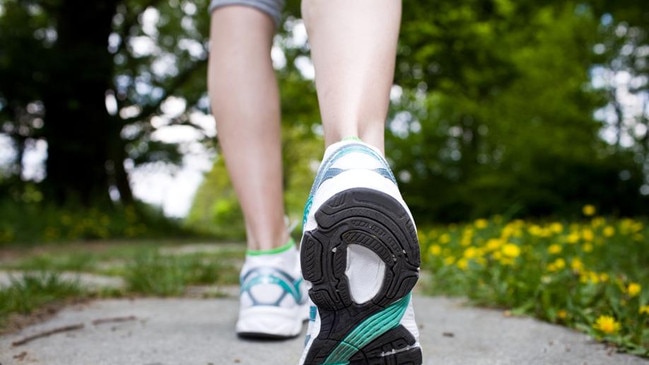Health and fitness: How to stay fit after you’ve hit 40
Devotees of 10,000 steps a day may be in for a shock. From midlife on, exercise can prolong life, but you can go too far. How much is too much?

How long we can expect to live is determined largely by lucky genetics and lifestyle. One we can do nothing about; the other can be tweaked and adapted, potentially adding years to our lifespan.
Last week the Office for National Statistics announced the first fall in men’s life expectancy since records began in the early 1980s — a boy born between 2018 and 2020 would be expected to live until he is 79, down from 79.2 years since 2015-17, compared with a girl’s predicted longevity of 82.9 years. These figures coincide with the publication of two new studies showing how we can hike up our chances of living longer simply by tailoring our activity levels.
Remaining fit and healthy from midlife onwards can mitigate diseases of old age and prolong life by as much as a decade; that is unquestionable. Yet how much we need to move in our forties and fifties — and in what ways — to achieve this has until now been less clearly defined.
Is the trend for later-life marathons and triathlons the key or can we hope to extend our years by doing less? Both studies go some way to crystallising opinion on the required daily exercise dosage and the good news is that, at least when it comes to improving your lifespan, the workout demands are nowhere near as severe as you might imagine.
In the first of the papers, published in JAMA Network Open, researchers from the University of Massachusetts honed in on our daily step target and whether the blanket recommendation of 10,000 daily steps, set by health bodies and prompted by activity trackers, will have the desired effect on longevity.
Amanda Paluch, assistant professor of kinesiology at the Institute for Applied Life Sciences and the lead author of the study, gathered data on 2110 middle-aged men and women recruited for a larger trial that required them to wear an activity monitor between 2005 and 2006, when most of them were in their forties. Over the next decade Paluch and her team followed the participants to see how they fared healthwise.
7000 STEPS WORKS
During that time, 72 of the participants died at a relatively young age, but Paluch’s statistics revealed that daily step count seemed to influence the risk of early mortality. “There was an incrementally lower risk of death with a higher number of steps per day — up to a certain point,” she says. “The sweet spot was achieving around 7000 to 10,000 steps per day.”
Surprisingly, it didn’t matter how slowly or quickly the participants walked each day. “We looked at peak 30-minute stepping rate, an individual’s natural best effort in walking pace throughout their day, and took the average,” Paluch says. “But we did not find any clear associations with stepping intensity.”

Increasing daily steps to beyond 10,000 also proved somewhat fruitless, with Paluch reporting no additional benefit in terms of mortality risk among those of her middle-aged participants who made an effort to clock up 12,000 daily steps or more. “It is not to say that above 10,000 steps a day was harmful at all — there just did not appear to be much additional gain beyond taking at least 7000 steps a day,” she says. “There was a point of diminishing returns.”
This plateau in potential gains for mid-lifers is, Paluch says, “strikingly consistent in research”, with others reporting a similar levelling off of benefits with high levels of exercise “whether measured as steps per day or as moderate-to-vigorous-intensity physical activity”. Paluch stresses that it doesn’t mean you shouldn’t do it, just that you should not expect to live longer as a result.
This sentiment is echoed in the second of the recent studies published in the journal Mayo Clinic Proceedings. This time, Danish researchers wanted to find out how long we need to spend doing different activities for them to present cardiovascular and other benefits that might extend our lifespan. They looked at tennis, badminton, football, cycling, swimming, jogging, resistance and weight training, and badminton, among others.
EXERCISE SWEET SPOT
Peter Schnohr, a cardiologist on the Copenhagen City Heart Study based at the Bispebjerg-Frederiksberg Hospital and the lead author of the paper, used data from 8697 people who had signed up for the heart study in the 1990s and had been tracked for the next 25 years when they were mostly in their sixties or older.
Since his study started, almost half of the participants had died, but Schnohr found that those who took part in sports and exercise sessions for at least 2.6 hours a week up to 4.5 hours a week were 40 per cent less likely to have died than those who did it for 2.5 weekly hours or fewer.
However, he too found that packing in more exercise was not beneficial and that for the most physically active — those who amassed 10-plus hours a week or 90 minutes a day of sports and gym classes — the longevity outcome was negative.
TOO MUCH OF A GOOD THING
Schnohr says the evidence points to exercise in midlife being beneficial in preventing mortality, but that more is not better. “The main reason seems to be related to the fact that too much sport or physical training every day allows for insufficient rest and recuperation, which is not good for our health,” he says. “Somewhere in the middle is best when it comes to exercising to live longer and too much is not good.”

Before you put your feet up, it is worth remembering that most middle-aged people do not meet even the minimum levels for longer living outlined in these studies. Figures from Sport England’s most recent Active Lives Adult Survey show a consistent drop in activity levels among the 35-54 age group, a downward trend seen even before the pandemic started and 27.1 per cent of adults did less than an average 30 minutes’ activity a week last year.
According to the NHS, the average British person walks only between 3000 and 4000 steps a day. That, Paluch says, should be your motivation. “You can get a lot of benefit from increasing to 7000 daily steps,” she says. “I really have taken my research to heart and certainly I plan to practise what I research. Maintaining our activity as we age is meaningful for our health.”
MIDLIFE RULES FOR LONGEVITY
COVER 5.6km A DAY
For the average adult, 2000 steps equal about 1600m — one mile. Your aim is a minimum of 7000 steps, or 5.6km, up to 10,000 steps (8km) a day. Speed and intensity don’t matter — just get those steps in.
AIM FOR 2.6 to 4.5 HOURS A WEEK OF GYM CLASSES
Peter Schnohr says that the figures from his study tally with the recommendations from Amanda Paluch’s findings and that, after daily steps for general living, doing a sport or gym class for 2.6 hours a week would bring you up to a daily total of about 7000 steps, and a 4.5-hour-a-week exercise habit would mean you get about 10,000 daily steps.

TRY BADMINTON. CYCLING OR FOOTBALL
Provided your overall weekly sports participation is not excessive, Schnohr says that tennis, badminton, football, cycling, swimming, jogging, and resistance and weight training all have benefits when it comes to extending your lifespan.
DON’T OVERDO IT
Hardcore training from your fifties and sixties onwards should be handled with care. “We showed that the people who did ten hours each week of sport, or about 90 minutes each day, reduced the mortality benefits by about one third compared with the more moderate exercisers,” Schnohr says.
The Times







To join the conversation, please log in. Don't have an account? Register
Join the conversation, you are commenting as Logout